M7U1 reading and project回归教材与翻译
高考英语 m7u1project课件 牛津选修7

terminal
1. When he was rushed to the hospital, he was examined ___________cancer.
terminal
2. Excuse me, where is the __________ of the train ?
Tips
Language points
provide supply offer
provide sb. with sth./provide sth. for sb. supply sb. with sth. /supply sth. to/for sb. offer sb. sth./offer sth. to sb./offer to do
vt.供给, 提供, n.补给,供给量(pl.)
vt.提出,试图要做……,出价, n.提议
offer advice offer sb. a cup of tea offer sb. 100 yuan for the bike refuse/accept an offer water supply household supplies provide the ship with radar
Different functions of mobile phones
taking photos
listening to music
surfing on the Internet
sending short messages
playing games
—a newspaper article
Limiting the amount of time you spend on your mobile phone. Moving the phone away from the body by using a handsfree kit or loudspeaking mode if available or why not consider texting as an alternative. Checking the SAR of a phone before you buy it, although the power which a phone transmits is controlled by the network and in many situations is far lower than its maximum power. Turning your phone off when you don’t need to use it .
牛津M7U1-Reading

1. What did the first TV in your home look like? How big was it? What was the picture like?
Review
Words and expressions
单词回顾
学生早读时已预习过本单元单 词,可利用几分钟时间带学生 快速回顾温习。对单词的熟练 度越高,阅读的速率也越高。
Words Review
evolution n. 演变,发展,进化 drawback n. 缺点,缺陷,不利条件 principle n. 原理,法则,道德原则,
3. Some of the first tape recorders used plastic tape to record on.
4. Records and cassettes do not offer as good a sound quality as CDs.
5. New technology will soon make many of the things talked about in the article out of date.
Scanning
Reading Comprehension III
1. Colour TV became popular within just a few years after it was invented.
2. People without satellite dishes do not benefit at all from satellite TV broadcasts.
M7U1readingandproject回归教材与翻译
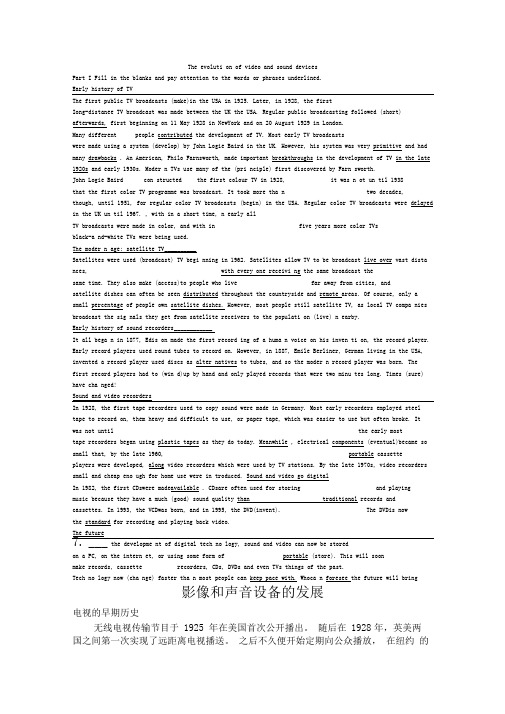
The evoluti on of video and sound devicesPart I Fill in the blanks and pay attention to the words or phrases underlined.Early history of TVThe first public TV broadcasts (make)in the USA in 1925. Later, in 1928, the firstIong-distanee TV broadcast was made between the UK the USA. Regular public broadcasting followed (short) afterwards, first beginning on 11 May 1928 in NewYork and on 20 August 1929 in London.Many different people contributed the development of TV. Most early TV broadcastswere made using a system (develop) by John Logie Baird in the UK. However, his system was very primitive and had many drawbacks . An American, Philo Farnsworth, made important breakthroughs in the development of TV in the late 1920s and early 1930s. Moder n TVs use many of the (pri nciple) first discovered by Farn sworth.John Logie Baird con structed the first colour TV in 1928, it was n ot un til 1938that the first color TV programme was broadcast. It took more tha n two decades,though, until 1951, for regular color TV broadcasts (begin) in the USA. Regular color TV broadcasts were delayed in the UK un til 1967. , with in a short time, n early allTV broadcasts were made in color, and with in five years more color TVsblack-a nd-white TVs were being used.The moder n age: satellite TV __________Satellites were used (broadcast) TV begi nning in 1962. Satellites allow TV to be broadcast live over vast dista nces, with every one receivi ng the same broadcast thesame time. They also make (access)to people who live far away from cities, andsatellite dishes can often be seen distributed throughout the countryside and remote areas. Of course, only a small percentage of people own satellite dishes. However, most people still satellite TV, as local TV compa nies broadcast the sig nals they get from satellite receivers to the populati on (live) n earby.Early history of sound recorders ____________It all bega n in 1877, Edis on made the first record ing of a huma n voice on his inven ti on, the record player. Early record players used round tubes to record on. However, in 1887, Emile Berliner, German living in the USA, invented a record player used discs as alter natives to tubes, and so the moder n record player was born. Thefirst record players had to (win d)up by hand and only played records that were two minu tes long. Times (sure) have cha nged!Sound and video recordersIn 1928, the first tape recorders used to copy sound were made in Germany. Most early recorders employed steel tape to record on, them heavy and difficult to use, or paper tape, which was easier to use but often broke. It was not until the early mosttape recorders began using plastic tapes as they do today. Meanwhile , electrical components (eventual)became so small that, by the late 1960, portable cassetteplayers were developed, along video recorders which were used by TV stations. By the late 1970s, video recorders small and cheap eno ugh for home use were in troduced. Sound and video go digitalIn 1982, the first CDswere madeavailable . CDsare often used for storing and playingmusic because they have a much (good) sound quality than traditional records andcassettes. In 1993, the VCDwas born, and in 1995, the DVD(invent). The DVDis nowthe standard for recording and playing back video.The future7. ___ the developme nt of digital tech no logy, sound and video can now be storedon a PC, on the intern et, or using some form of portable (store). This will soonmake records, cassette recorders, CDs, DVDs and even TVs things of the past.Tech no logy now (cha nge) faster tha n most people can keep pace with. Whoca n foresee the future will bring影像和声音设备的发展电视的早期历史无线电视传输节目于1925 年在美国首次公开播出。
最新m7u1reading知识点教学讲义PPT
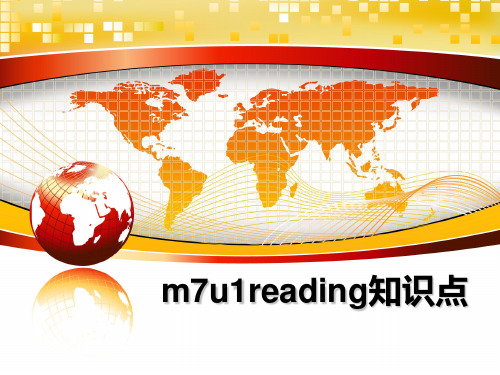
m7u1reading知识点
• Step 1. Fill in the blanks with proper words.
• 1. It has passed through an interesting procedure of evolution (进化). 它经过了一个有趣的进化过程。
• 2. In recent years our country has placed great importance on economic construction (建设).
today. • The match was postponed to the next day because
of bad weather.
知识生成
• 3. Of course, only a small percentage of people own satellite dishes.
• 2) opposed adj.对立的,相反的 be opposed to…反对(to是介词) e.g. I’m much opposed to your going abroad.
• opposite adj.相反的,对立的 n.相反的事物 对立 面 prep.(表示位置)在…的对面
• opposition n.反对,反抗 • opponent n.对手,敌手
• delay vt.&vi. (使)推迟,延迟 • delay doing 推迟做某事 • delay n. 延期,延缓,推迟 • without delay毫无迟延地,立即= at once • e.g. You need to get those vegetables planted
牛津高中英语模块7 m7u1project 课件

Write the outline梗概,大纲,提纲of the passage.
Part 1(Para1-2) __In_t_r_o_d_u_c_ti_o_n__to the Amish way of life
Part 2(Para3-6) __D_i_s_a_d_v_a_n_ta_g_e_s__of the telephone
As we all know, every coin has two sides. First, it is believed that middle school students are too young to control themselves. What’s worse, it is a waste of time to play games or send short messages.
eye-catching 引人注目的
Do you have a mobile phone? What do you often use it for besides making calls?
taking photos
listening to music
surfing on the Internet
Writing structure
• Introduction • Advantages / evidence • Disadvantages / evidence • Conclusion
【题目要求】 现在,很多学生带手机(mobile phone)上学。为此,某 英语报在你校组织了一场讨论。讨论的主题:中学生是 否有必要带手机去学校。请你给报社写一封信,介绍它 的利弊。
用适当的介词填空。 1)I shall vote __fo_r_ (for/against) Bert because I think he’s the best man. 2)As we can’t reach an agreement on this matter, let’s vote _o_n_ (down/out/on) it.
最新M7U1-Project教学讲义PPT课件

Lead-in
Can you list some functions of mobile phones?
ቤተ መጻሕፍቲ ባይዱ
Playing games
playing games
Surfing the Internet
What functions does a cellphone have?
If the writer is likely to lay emphasis on(强 调)__n_o_t_t_o_p__h_o_n_e_, he will give examples about _t_h_e_p__o_s_si_b_le__d_i_sa_d_v_a_n__ta_g_e_s_o__f _p_h_o_n_e_s_..
Now let’s read a newspaper article about one group of people who has rejected most modern technology.
Reading strategy
How to read a newspaper article? To phone or not to phone?
Read the first two paragraph, and find answers to the following questions.
1. What group of people are talked about?
The Amish in the USA.
2. What do you know about this group of people? A Christian group who are famous for having rejected most modern technology.
牛津译林版高中英语选修七M7U1Project

高中英语学习材料madeofjingetiejiUnit 1 of Module 7 ProjectMaking a list of advantages and disadvantagesLearning Aims:1. Improve English through doing a project.Important and difficult points:1.Learn something about how to make a list.2. Master the meanings and usages of some words and phrases.Learning procedures:Part One-Self-explorationI. Remember the following important phrases.1. a Christian group 一个基督教团体2.introduce technology 引进技术3. electric company 电力公司4.face to face 面对面地5. be convenient for 对……方便6. over a telephone wire 通过电话线7. that important 那么重要8. be absorbed in 专心致志于9. interrupt the conversation 打断谈话10. text message 短消息11. focus on 专注于12. for good measure 额外地13. rid … of…使……摆脱14. electronic devices 电子装置15. in truth 事实上16. oppose having telephones 反对拥有电话II. Fast reading.1. Which group of people are talked about?_______________________________________________________2. What do you know about this group of people?_______________________________________________________3. Why do they reject most modern technology?_______________________________________________________III. Enjoy the following sentences, fill in each blank with a proper word, and then translate them into Chinese orally.1.In the USA, the Amish—________ ________ ________(一个基督教团体) —are famous because they drive carriages ________ _________ cars, do not use TVs or refrigerators, and do not have ________ _________(私人电话).2.________ _________(实际上),________ (无论何时) a new technology is ________ (被引进), the Amish meet and discuss its ________ ________ _________(优点和缺点).3.________ (由于)the Amish ________ ________ ________ _________ _________________(重视面对面的交流), they ________ ________ _________(反对拥有电话) in their houses.4.Then, when you ________ ________ _________(专注于) a book or simply trying to rest, the phone ________ _________ ________ _________ _________(似乎总是响个不停), ________ _________ peace you might have(打破了你本来可以享有的一切安宁).5.Maybe we should throw all of our phones into the dustbin, ________ ________ (连同)our cars and TVs ________ _________ _________(额外地).6.Maybe we should ________ ourselves ________ (摆脱)modern technology and return to simpler times.IV. Fill in the blanks according to the text.Title To phone or not to phone?(1) ___________to the Amish way of life In the USA, the Amish are famous because they don’t use any(2)_________technology such as TVs, private telephones. They think phones are not their (3) __________and dislike dealing with strangers.(4)_________ of the telephone ·There is something important about staying (5)_________ and sharing life not found over a telephone wire.·(6)__________ the circumstances are, when the telephone rings ,everyth ing is interrupted.Real relationships are often (7)__________ , and whatever personal peac e one has is destroyed whenever the phone rings.Possible (8)_________ to the use of phones Maybe we should (9)_________ away all of our phones into the dustbin. Maybe we should (10) _______ away from modern technology.V. Summary.In the USA there is a famous (1) ___________ group who drive carriages instead of cars and do not use TVs, refrigerators. It’s (2) ___________that the Amish must have religious reason,(3)__________ is not true. The fact is that whenever a new technology is introduced, the Amish get together and discuss the advantages and disadvantages. And as The Amish value seeing each other (4)_____________, they are(5) __________ to having telephones in their houses. It is (6)__________for most people to communicate through telephones but maybe the Amish have a (7)__________ __opinion. First of all, There is something important about being together and sharing life that can’t be (8)____________ through a telephone wire. Secondly, no matter what the (9)____________ _ are, when the phone rings, everything stops so that the call can be answered. In addition, real relationships are often (10) ___________ and the personal peace is destroyed.VI. Self-study of important and difficult language points.1. 【原句回放】S ince the Amish value seeing each other face to face, they oppose having telephones in their houses. (lines 21-23, page 14) 由于阿曼门罗教徒重视彼此面对面地交往,他们反对在住宅里装电话。
【最新】高中英语选修七:M7U1 Project 课件.ppt

_U_n_d_e_r_n_o__rm__a_l_c_ir_c_u_m__s_ta_n_c_e_s_,_n_obody would sign such an • unfair agreement.
• while用作__连__词_____,引导__让__步__状_语__从__句_,意思是 ___尽__管__、__虽__然______
• while 用法小结: • (1)在…期间,当…时候,引导状语从句,谓语动词要用
__延__续__性__动__词_____
• 老人在看报纸时睡着了 _T_h_e_o_l_d_m__a_n_f_e_ll_a_s_l_e_e_p_w__h_il_e_h_e__w_a_s_r_e_a_d_in_g__n_e_w_s_p_a_p_e_rs.
• (2) 而,然而,用于两种情况的对比
• 我喜欢喝茶,而他喜欢喝咖啡 __I _lik_e__d_ri_n_k_in_g__te_a__w_h_il_e_h_e__lik_e_s__c_o_ff_e_e_. ________
• (3)”虽然,尽管“引导让步状语从句,相当于th_o_u_g_h_/_a_lt_h_o_u_g_h
Unit 1 Living with technology
Reading strategy
a newspaper article
the title the first paragraph
Creaardefiunlgreading
1.Structure of the passage Part One(Para1) _I_n_t_ro__d_u_c_t_i_o_n__ of a Christian group.
七年级上册英语书m7u1课文
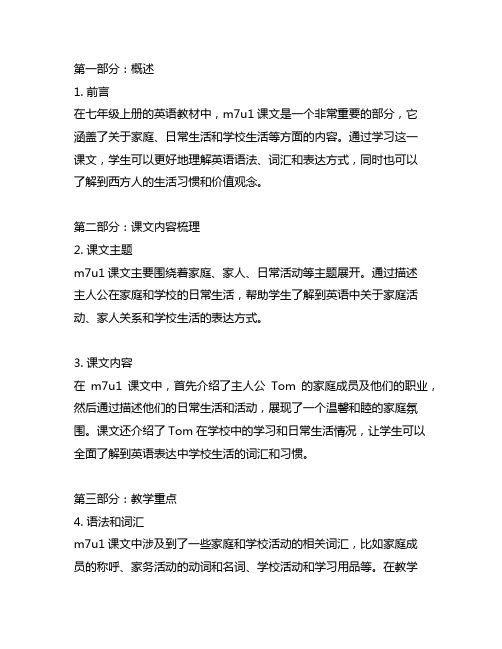
第一部分:概述1. 前言在七年级上册的英语教材中,m7u1课文是一个非常重要的部分,它涵盖了关于家庭、日常生活和学校生活等方面的内容。
通过学习这一课文,学生可以更好地理解英语语法、词汇和表达方式,同时也可以了解到西方人的生活习惯和价值观念。
第二部分:课文内容梳理2. 课文主题m7u1课文主要围绕着家庭、家人、日常活动等主题展开。
通过描述主人公在家庭和学校的日常生活,帮助学生了解到英语中关于家庭活动、家人关系和学校生活的表达方式。
3. 课文内容在m7u1课文中,首先介绍了主人公Tom的家庭成员及他们的职业,然后通过描述他们的日常生活和活动,展现了一个温馨和睦的家庭氛围。
课文还介绍了Tom在学校中的学习和日常生活情况,让学生可以全面了解到英语表达中学校生活的词汇和习惯。
第三部分:教学重点4. 语法和词汇m7u1课文中涉及到了一些家庭和学校活动的相关词汇,比如家庭成员的称呼、家务活动的动词和名词、学校活动和学习用品等。
在教学中,可以重点学习这些词汇的用法和搭配,同时也可以结合上下文来学习相关的语法知识,比如动词的时态和名词的复数形式等。
5. 句型和表达除了词汇和语法知识外,m7u1课文中还涉及到了一些常用的句型和表达方式,比如描述家庭成员的外貌特征、提及日常活动和学习情况等。
在教学中,可以重点训练学生运用这些句型和表达方式,使他们能够准确、流畅地表达自己的想法和情感。
第四部分:学习方法6. 听说读写针对m7u1课文的学习,可以采取听、说、读、写相结合的学习方法。
首先通过听课文录音,使学生熟悉并掌握课文的语音语调;然后通过口头练习,训练学生的口语表达能力;接着通过阅读课文和相关练习,巩固学生的词汇和语法知识;最后通过写作练习,训练学生的书面表达能力。
7. 听力训练在学习m7u1课文时,可以配合一些听力练习,比如听力填空、听力选择等,让学生通过听力练习加深对课文内容的理解,并提高他们的听力水平。
第五部分:拓展延伸8. 课外阅读除了课本上的课文外,还可以引导学生进行一些相关的课外阅读,比如家庭和学校生活的相关故事、文章或实用资料等,让学生在拓展自己知识的也能够更深入地了解到相关的文化和生活习惯。
译林高中英语模块4课文翻译(reading和project)

译林高中英语模块4课文翻译(reading和project)Unit1Reading如今,无论我们走到哪里,几乎都可以看见广告。
我们已经对广告习以为常,甚至常常都意识不到在一天中看见或听见多少广告。
我对广告进行了一些研究,有一些非常重要的信息要与你分享。
什么是广告?广告使用文字、图片来说服人们购买一种产品或服务,或者接受某种观念。
报纸、杂志、互联网、广播和电视是最常见到广告的地方。
广告有两种主要的形式——商业广告和公益广告(简称PSAs)。
商业广告是为了推销某种产品或服务而花钱做的广告。
公益广告往往是免费投放的,旨在就有关健康、安全或影响到公共福利的任何其他问题教育人们。
广告告诉人们全部实情了吗?尽管有法律保护人们免受虚假广告的侵害。
但是我们仍然应该了解广告中试图向我们兜售东西的常用技巧。
即使一则广告没有撒谎,也并不意味着它就是完全“清白”的。
一则牙膏广告宣称“亮齿牌牙膏挑战口臭!”这一表述试图糊弄你,让你误以为这种牙膏可以治愈口臭,但事实上广告中并没有这样说!广告所说的就是牙膏“挑战”口臭,这和“治愈”根本不是一回事。
一家食品杂货店告诉顾客.“您为自己的厨艺骄傲,难首您不应该购买最新鲜的食品吗?”这则广告非常聪明,聪明就聪明在它恭维顾客是好厨师。
但是,它决不声称本店供应的是最新鲜的食品。
这家食品杂货店只是希望当你读到这则广告时,你会很乐于看到其中的恭维,记住“最新鲜的食品”这个词,在心理上将其与该店里的食品联系起来。
我们切莫掉进这类陷阱中。
公益广告但并非所有的广告都跟我们玩花招。
公益广告使用一些同样的方法,例如用吸引人的图片和巧妙的文字,但是它们的目的是服务公众。
公益广告旨在教育我们,并帮助我们过上更好的生活。
我们的政府了解这一点,多年来一直用公益广告教育人们。
中国于1996年开始一场全国性的公益广告宣传活动,从那时起、多种形式的公益广告在中国出现。
你自己可能就看到过或听说过其中的一些,例如“珍爱生命,远离毒品”以及“知识改变命运”。
译林牛津版 M7U1 Project
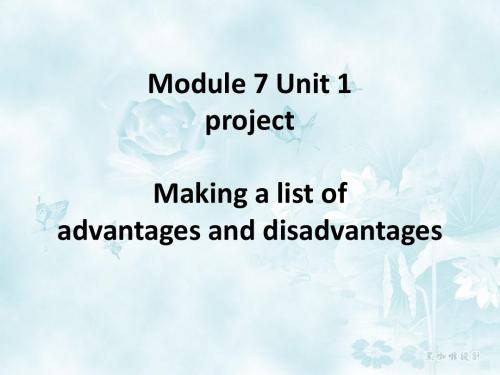
2.Why does the author offer the solutions with “maybe”?
Reading strategy
How to read a newspaper article: To phone or not to phone? Q: When you read the title, what do you think of? The writer may pay more attention to _____________and the passage may mainly tell not to phone some disadvantages us______________________ of phone. the title:
ห้องสมุดไป่ตู้
Reading
Read the next four paragraphs (Paras 3-6) carefully and try to find out the disadvantages of using phones. The disadvantages of using phones.
The disadvantages
Write the outline of the passage. Part 1(Para1-2) Introduction to way of life. Part 2(Para3-6) Disadvantages
the Amish
of the
牛津译林版高中英语选修七M7U1Reading(2)
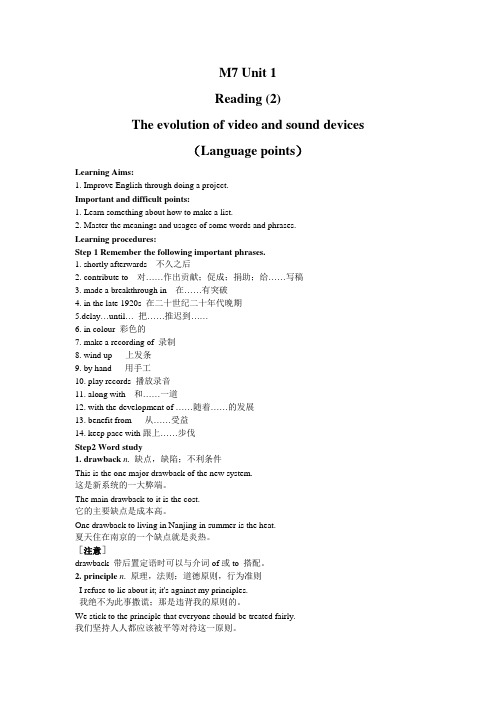
M7 Unit 1Reading (2)The evolution of video and sound devices(Language points)Learning Aims:1. Improve English through doing a project.Important and difficult points:1.Learn something about how to make a list.2. Master the meanings and usages of some words and phrases.Learning procedures:Step 1 Remember the following important phrases.1. shortly afterwards 不久之后2. contribute to 对……作出贡献;促成;捐助;给……写稿3. made a breakthrough in 在……有突破4. in the late 1920s 在二十世纪二十年代晚期5.delay…until…把……推迟到……6. in colour 彩色的7. make a recording of 录制8. wind up 上发条9. by hand 用手工10. play records 播放录音11. along with 和……一道12. with the development of ……随着……的发展13. benefit from 从……受益14. keep pace with跟上……步伐Step2 Word study1. drawback n. 缺点,缺陷;不利条件This is the one major drawback of the new system.这是新系统的一大弊端。
The main drawback to it is the cost.它的主要缺点是成本高。
八下英语m7u1课文翻译
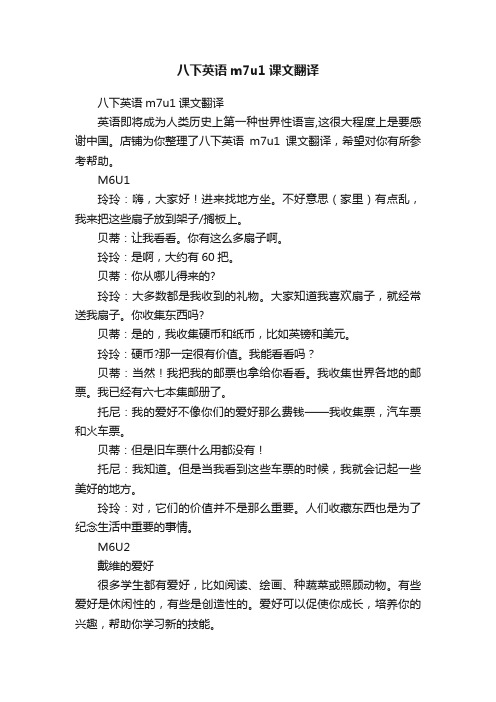
八下英语m7u1课文翻译八下英语m7u1课文翻译英语即将成为人类历史上第一种世界性语言,这很大程度上是要感谢中国。
店铺为你整理了八下英语m7u1课文翻译,希望对你有所参考帮助。
M6U1玲玲:嗨,大家好!进来找地方坐。
不好意思(家里)有点乱,我来把这些扇子放到架子/搁板上。
贝蒂:让我看看。
你有这么多扇子啊。
玲玲:是啊,大约有60把。
贝蒂:你从哪儿得来的?玲玲:大多数都是我收到的礼物。
大家知道我喜欢扇子,就经常送我扇子。
你收集东西吗?贝蒂:是的,我收集硬币和纸币,比如英镑和美元。
玲玲:硬币?那一定很有价值。
我能看看吗?贝蒂:当然!我把我的邮票也拿给你看看。
我收集世界各地的邮票。
我已经有六七本集邮册了。
托尼:我的爱好不像你们的爱好那么费钱——我收集票,汽车票和火车票。
贝蒂:但是旧车票什么用都没有!托尼:我知道。
但是当我看到这些车票的时候,我就会记起一些美好的地方。
玲玲:对,它们的价值并不是那么重要。
人们收藏东西也是为了纪念生活中重要的事情。
M6U2戴维的爱好很多学生都有爱好,比如阅读、绘画、种蔬菜或照顾动物。
有些爱好是休闲性的,有些是创造性的。
爱好可以促使你成长,培养你的兴趣,帮助你学习新的技能。
戴维史密斯是一名学生,他的爱好之一是写作。
在2010年的夏天,他参加了一个为期4周的夏令营。
除了像帆船运动和爬山这些常见的活动以外,夏令营还有一门写作课程。
“老师是一位作家,她让我们谈论我们谈论自己的生活、讲有趣的故事,然后鼓励我们把夏令营的经历写下来。
”回到学校后,戴维以一名16岁男孩的生活为题材写了一个故事,并于2012年成书出版。
很多青少年都喜欢读他的书,戴维也因此成为一名成功的少年作家。
戴维是幸运的,因为他的爱好给他带来了快乐和成功。
但写作不是他唯一的爱好,他对许多其他的东西也很感兴趣。
“我也喜欢打排球,”戴维说,“我有一部分业余时间就用来在校队打排球。
也许我会在将来的书里写写我们排球队的事情。
”M7U1(玲玲正在为她的洛杉矶之旅作准备)玲玲:嗨,贝蒂。
外研八下英语M7U1微课精讲+知识点总结
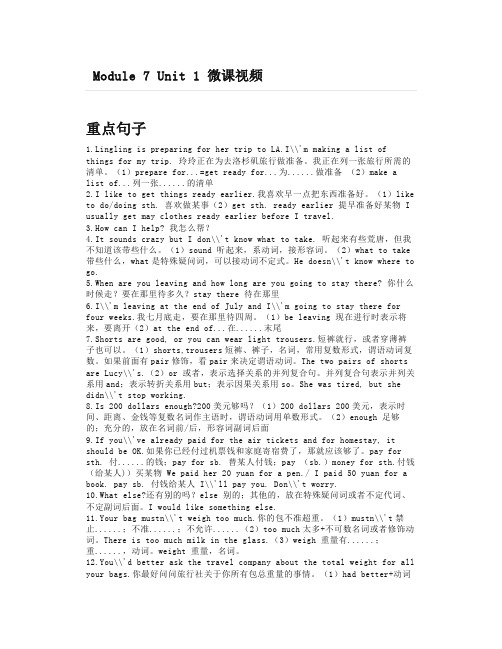
Module 7 Unit 1 微课视频重点句子1.Lingling is preparing for her trip to LA.I\\'m making a list ofthings for my trip. 玲玲正在为去洛杉矶旅行做准备。
我正在列一张旅行所需的清单。
(1)prepare for...=get ready for...为......做准备(2)make alist of...列一张......的清单2.I like to get things ready earlier.我喜欢早一点把东西准备好。
(1)like to do/doing sth. 喜欢做某事(2)get sth. ready earlier 提早准备好某物 I usually get may clothes ready earlier before I travel.3.How can I help? 我怎么帮?4.It sounds crazy but I don\\'t know what to take. 听起来有些荒唐,但我不知道该带些什么。
(1)sound 听起来,系动词,接形容词。
(2)what to take 带些什么,what是特殊疑问词,可以接动词不定式。
He doesn\\'t know where to go.5.When are you leaving and how long are you going to stay there? 你什么时候走?要在那里待多久?stay there 待在那里6.I\\'m leaving at the end of July and I\\'m going to stay there for four weeks.我七月底走,要在那里待四周。
(1)be leaving 现在进行时表示将来,要离开(2)at the end of...在......末尾7.Shorts are good, or you can wear light trousers.短裤就行,或者穿薄裤子也可以。
高中牛津英语所有模块的Reading和project课文翻译!
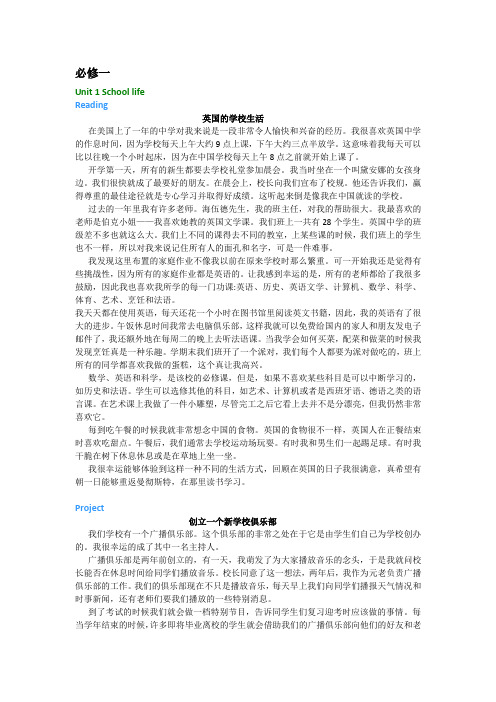
必修一Unit 1 School lifeReading英国的学校生活在美国上了一年的中学对我来说是一段非常令人愉快和兴奋的经历。
我很喜欢英国中学的作息时间,因为学校每天上午大约9点上课,下午大约三点半放学。
这意味着我每天可以比以往晚一个小时起床,因为在中国学校每天上午8点之前就开始上课了。
开学第一天,所有的新生都要去学校礼堂参加晨会。
我当时坐在一个叫黛安娜的女孩身边。
我们很快就成了最要好的朋友。
在晨会上,校长向我们宣布了校规。
他还告诉我们,赢得尊重的最佳途径就是专心学习并取得好成绩。
这听起来倒是像我在中国就读的学校。
过去的一年里我有许多老师。
海伍德先生,我的班主任,对我的帮助很大。
我最喜欢的老师是伯克小姐——我喜欢她教的英国文学课。
我们班上一共有28个学生。
英国中学的班级差不多也就这么大。
我们上不同的课得去不同的教室,上某些课的时候,我们班上的学生也不一样,所以对我来说记住所有人的面孔和名字,可是一件难事。
我发现这里布置的家庭作业不像我以前在原来学校时那么繁重。
可一开始我还是觉得有些挑战性,因为所有的家庭作业都是英语的。
让我感到幸运的是,所有的老师都给了我很多鼓励,因此我也喜欢我所学的每一门功课:英语、历史、英语文学、计算机、数学、科学、体育、艺术、烹饪和法语。
我天天都在使用英语,每天还花一个小时在图书馆里阅读英文书籍,因此,我的英语有了很大的进步。
午饭休息时间我常去电脑俱乐部,这样我就可以免费给国内的家人和朋友发电子邮件了,我还额外地在每周二的晚上去听法语课。
当我学会如何买菜,配菜和做菜的时候我发现烹饪真是一种乐趣。
学期末我们班开了一个派对,我们每个人都要为派对做吃的,班上所有的同学都喜欢我做的蛋糕,这个真让我高兴。
数学、英语和科学,是该校的必修课,但是,如果不喜欢某些科目是可以中断学习的,如历史和法语。
学生可以选修其他的科目,如艺术、计算机或者是西班牙语、德语之类的语言课。
在艺术课上我做了一件小雕塑,尽管完工之后它看上去并不是分漂亮,但我仍然非常喜欢它。
- 1、下载文档前请自行甄别文档内容的完整性,平台不提供额外的编辑、内容补充、找答案等附加服务。
- 2、"仅部分预览"的文档,不可在线预览部分如存在完整性等问题,可反馈申请退款(可完整预览的文档不适用该条件!)。
- 3、如文档侵犯您的权益,请联系客服反馈,我们会尽快为您处理(人工客服工作时间:9:00-18:30)。
The evolution of video and sound devicesPart I Fill in the blanks and pay attention to the words or phrases underlined.Early history of TVThe first public TV broadcasts 1.________(make)in the USA in 1925. Later, in 1928, the first long-distance TV broadcast was made between the UK 2._____ the USA. Regular public broadcasting followed 3._________(short) afterwards, first beginning on 11 May 1928 in New York and on 20 August 1929 in London.Many different people contributed 4.______ the development of TV. Most early TV broadcasts were made using a system 5.__________(develop) by John Logie Baird in the UK. However, his system was very primitive and had many drawbacks. An American, Philo Farnsworth, made important breakthroughs in the development of TV in the late 1920s and early 1930s. Modern TVs use many of the 6._________(principle) first discovered by Farnsworth.John Logie Baird constructed the first colour TV in 1928, 7._____ it was not until 1938 that the first color TV programme was broadcast. It took more than two decades, though, until 1951, for regular color TV broadcasts 8.________(begin) in the USA. Regular color TV broadcasts were delayed in the UK until 1967. 9.________, within a short time, nearly all TV broadcasts were made in color, and within five years more color TVs 10.______ black-and-white TVs were being used.The modern age: satellite TVSatellites were used 1.___________(broadcast) TV beginning in 1962. Satellites allow TV to be broadcast live over vast distances, with everyone receiving the same broadcast 2._____ the same time. They also make TV3.____________(access)to people who live far away from cities, and satellite dishes can often be seen distributed throughout the countryside and remote areas. Of course, only a small percentage of people own satellite dishes.However, most people still benefit4._______ satellite TV, as local TV companies broadcast the signals they get from satellite receivers to the population 5._________(live) nearby.Early history of sound recordersIt all began in 1877, 6._____Thomas Edison made the first recording of a human voice on his invention, the record player. Early record players used round tubes to record on. However, in 1887, Emile Berliner, 7.______ German living in the USA, invented a record player 8.______ used discs as alternatives to tubes, and so the modern record player was born. The first record players had to9._________(wind)up by hand and only played records that were two minutes long. Times10._______(sure) have changed!Sound and video recordersIn 1928, the first tape recorders used to copy sound were made in Germany. Most early recorders employed steel tape to record on, 1._____made them heavy and difficult to use, or paper tape, which was easier to use but often broke. It was not until the early 1950s2.______ most tape recorders began using plastic tapes as they do today. Meanwhile, electrical components 3.__________(eventual)became so small that, by the late 1960, portable cassette players were developed, along 4.______ video recorders which were used by TV stations. By the late 1970s, video recorders small and cheap enough for home use were introduced.Sound and video go digitalIn 1982, the first CDs were made available. CDs are often used for storing and playing music because they have a much 5._________(good) sound quality than traditional records and cassettes. In 1993, the VCD was born, and in 1995, the DVD 6._________(invent). The DVD is now the standard for recording and playing back video.The future7.______ the development of digital technology, sound and video can now be stored on a PC, on the internet, or using some form of portable 8._________(store). This will soon make records, cassette recorders, CDs, DVDs and even TVs things of the past. Technology now9._____________(change) faster than most people can keep pace with. Who can foresee10._______ the future will bring?影像和声音设备的发展电视的早期历史无线电视传输节目于1925年在美国首次公开播出。
随后在1928年,英美两国之间第一次实现了远距离电视播送。
之后不久便开始定期向公众播放,在纽约的开播时间是1928年5月11日,在伦敦的开播时间是1929年8月20日。
很多不同的人对电视的发展做出了贡献。
早期电视大多使用有英国人约翰洛吉贝尔德开发的系统。
然而,他的系统非常原始,有许多缺点。
20世纪20年代末和30年代初,美国人斐洛法恩斯沃斯在电视的研发上取得了重大突破。
现代电视机使用了许多由法恩斯沃斯首先发现的原理。
约翰洛吉贝尔德于1928年制造出第一台彩色电视机,但直到1938年第一个彩色电视节目才播出。
彩色电视节目到1951年才得以在美国定期播出,其间经历了二十多年的时间。
在英国,定期的彩色电视节目的播出一直延迟至1967年。
然而,在短时间内,几乎所有的电视节目都被制作成了彩色的,不出五年,彩色电视机的使用率就超过了黑白电视机。
当代:卫星电视卫星用于播送电视节目始于1962年。
卫星让远距离直播电视节目成为可能,大家在同一时间可以收到相同的电视节目。
它们也使远离城市的人们可以收看电视,在农村和边远地区经常可以看到卫星天线。
